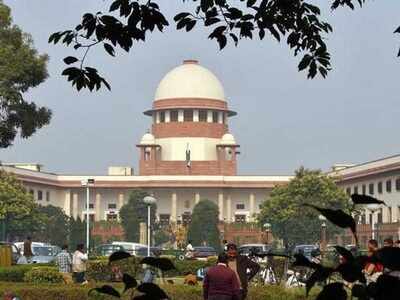Top Searches
- News
- India News
- ‘Bail, not jail’ norm not for gangsters: SC

NEW DELHI: The Supreme Court has advised all high courts not to mechanically apply the ‘bail not jail’ principle while giving relief to gangsters, sharpshooters and heinous offenders and must weigh the effect of such bail on the safety of witnesses and families of victims.
Heading a three-judge bench, CJI S A Bobde on Friday – the last day of his retirement – cancelled the bail granted by Allahabad HC to Azamgarh gangster Arun Yadav, who was accused of gunning down one Rajnarain Singh. Singh’s widow had challenged the bail to Yadav, who faced 15 cases of murder or attempt to murder.
The SC recalled the case relating to grant of parole to Vikas Dubey. “The appellant cites the example of a person who was prosecuted in connection with 64 criminal cases which included cases of murders, offences of dacoity, criminal intimidation, extortion and offences under the UP-Gangster Act, etc, but who was released on bail. Ultimately, when a police team went to apprehend him, allegedly eight policemen were killed,” the bench noted.
It said, “We find in this case the HC has overlooked aspects, such as the potential threat to witnesses, forcing the trial court to grant protection (to the victim’s family). It is needless to point out that in cases of this nature, it is important that courts do not enlarge an accused on bail with a blinkered vision.” SC advised the HCs to examine a bail plea on these principles: Whether there was prima facie or reasonable ground to believe the accused had committed the offence; nature and gravity of accusations; severity of punishment in the event of conviction; danger of accused absconding or fleeing if granted bail; character, behaviour, means, position and standing of the accused; likelihood of repetition of offence; reasonable apprehension of witnesses being influenced; and danger of justice being thwarted.
Heading a three-judge bench, CJI S A Bobde on Friday – the last day of his retirement – cancelled the bail granted by Allahabad HC to Azamgarh gangster Arun Yadav, who was accused of gunning down one Rajnarain Singh. Singh’s widow had challenged the bail to Yadav, who faced 15 cases of murder or attempt to murder.
The SC recalled the case relating to grant of parole to Vikas Dubey. “The appellant cites the example of a person who was prosecuted in connection with 64 criminal cases which included cases of murders, offences of dacoity, criminal intimidation, extortion and offences under the UP-Gangster Act, etc, but who was released on bail. Ultimately, when a police team went to apprehend him, allegedly eight policemen were killed,” the bench noted.
It said, “We find in this case the HC has overlooked aspects, such as the potential threat to witnesses, forcing the trial court to grant protection (to the victim’s family). It is needless to point out that in cases of this nature, it is important that courts do not enlarge an accused on bail with a blinkered vision.” SC advised the HCs to examine a bail plea on these principles: Whether there was prima facie or reasonable ground to believe the accused had committed the offence; nature and gravity of accusations; severity of punishment in the event of conviction; danger of accused absconding or fleeing if granted bail; character, behaviour, means, position and standing of the accused; likelihood of repetition of offence; reasonable apprehension of witnesses being influenced; and danger of justice being thwarted.
FacebookTwitterLinkedinEMail
end of article
Trending Topics
Top Stories Right Now
- indiaCovid-19: Daily cases touch 3.5 lakh; 2,760 die in 24 hours
- indiaCovaxin priced at Rs 600 for states, Rs 1200 for private hospitals
- indiaOnline registration must for 18+ to get Covid vaccine
- indiaCBI books ex-Maharashtra home minister Anil Deshmukh under PCA, IPC
- indiaGovt waives duty on oxygen, vaccine imports for 3 months
Quick Links
Coronavirus in MumbaiFarm bill 2020Farmers protestCoronavirus in DelhiCoronavirus in BangaloreCoronavirus symptomsCoronavirus in IndiaWest Bengal elections 2021Coronavirus NewsSolar EclipseNPRWhat is NRCCAB BillCAB and NRCAssam election 2021Podcast newsLok SabhaTamil Nadu Election 2021CongressBJP newsKerala Elections 2021Indian ArmyISRO newsSupreme Court